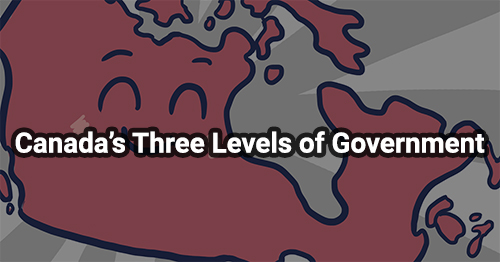Canada's Three Levels of Government

Imagine starting society from scratch. Imagine there are no laws, no schools, no roads, no jobs, no money - and no one owns anything.
You’d probably want to figure out how to get food. You would also want to figure out a place to stay. You should also get some clothes! You would have to figure out how to grow food, make your own clothes, and build a house.
Now imagine how long it would take to build a society like the one you live in today; think about all the things you’ll use today, and how many people had to be involved to make them available to you. For example, someone had to build the classroom you’re in. Someone had to build the roads too. Someone also had to build the cars, pencils, and chairs. Someone had to grow the food you’ll eat. Or think about what it takes to build a computer, phones… or the internet and satellites. Think about all of the people who are involved in everything you’ll do today. It’s a lot of people!
It takes hundreds of thousands of people working together to allow you to live the way you do. It would be impossible to do it alone. This is why we have a society where we can live and work together. Working together lets us accomplish things that we wouldn’t be able to do alone.
In order to work together though, we also have to agree on the rules. Some rules are obvious. For example, everyone agrees that murder is bad. Other rules are more complicated and not everyone can agree on them (e.g. what should the speed limit be for cars?). This is why we need a way to discuss what rules to follow, and a way to make sure everyone follows these rules.
This is the role of the government. The government is the institution that we use to create rules (also known as laws), and enforce them.
Three Levels of Government
Think about all the rules you already follow. Your school has rules. Maybe your classroom has rules. Or your family. Maybe you have rules between your friends. Or maybe you have your own set of rules in Smash Bros, or special rules for a game during recess.
It would be pretty weird if all of these rules were made by everybody. Imagine having to ask your teacher if a rule in a video game was fair. Or getting your friends permission to bring in a new rule in your family. When we make rules in our own lives, we only involve people that it directly affects. For example. when you’re on the playground playing a game, you discuss the rules with the people playing the game - not every student in the school.
The same is true in government. There are three levels of government that have different areas they are responsible for, depending on who it affects. These different responsibilities are laid out in the highest law of Canada (the most important law in Canada), the Constitution.
The three levels of government are Municipal, Provincial/Territorial, and Federal. We’ll take a closer look at each of these in the next sections. What you’ll soon notice is that while there are three levels, there are many overlapping responsibilities. As an example of one of these overlapping areas, we’ll be looking at health.
All lessons & quizzes are free!
This was just one of the lessons in our Canada's Three Levels of Government section. There are over 60 lessons on Kids Boost Immunity just like this one on a variety of subjects. Each lesson includes a quiz, and every time a student scores 80% or higher on a quiz, we will donate life-saving vaccines to UNICEF Canada. Sign up now!



